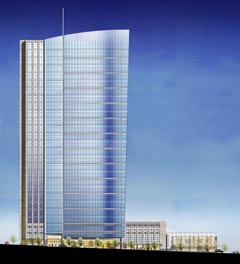Touchstone
Specialty: Commercial development with focus on commercial and technical office
Owners: Douglas Howe, James O’Hanlon, Shawn Parry
Year founded: 1982
Largest current project: Westlake Plaza

Image by Callison Architecture
Touchstone is targeting 2007 for completion of the $85 million Westlake Plaza. The 19-story office tower proposed for 718 Virginia St. will have 300,000 square feet of office space and 20,000 square feet of ground-level retail. |
President Douglas Howe estimated biotechnology and biomedical projects make up just 10 percent of Touchstone’s portfolio, but said the market could pick up steam under the right circumstances.
Seattle needs to see a few more success stories like Immunex, he said, before the sector takes off.
“Right now, there’s a very conservative environment” in the venture capital market, Howe said. But if biotech really gets going, he said there could be a need for 250,000 to 500,000 square feet a year in new private research and development space.
“With a very small market, it’s difficult to predict the timing of the need,” Howe said. “It’s not one of the main food groups of the office market — it’s a specialty market with a limited demand.”
Touchstone’s office projects include a 19-story tower called Westlake Plaza planned for a half-block bound by Westlake, Eighth and Virginia. The building, which will have 330,000 square feet of rentable space, is slated for completion in 2007.
The developer has also assembled a full-block at Stewart and Boren that, with an alley vacation, could result in a two-building “superproject” with up to 900,000 square feet of office and retail space and a large plaza.
|
Howe |
“It’s going to take a large anchor tenant,” Howe said of the project.
Howe said Touchstone is also working on a couple of 200,000-square-foot build-to-suit projects, but couldn’t elaborate.
Looking ahead, Howe said he sees office construction growing at a slower pace, tempered by shrinking space needs. Employers can do more now with fewer employees, and telecommuting is growing more common. Changing demographics, too, may mean fewer employees will be available to replace retiring baby boomers. At the same time, Howe said, employees are demanding higher quality space.
“They want good locations that are accessible and well-served by transit, good amenities and retail nearby. And neighborhoods that are mixed-use.
“There will be more and more competition for attracting and retaining good people. So employers are more aware of quality and location of space.”
One roadblock for employers is the slow pace of development in the region, Howe said. Though job growth is critical to the health of the economy, it takes three years to get a construction permit.
“Stormwater quality, shoreline and wetlands reform — these are starting to affect urban infill sites,” Howe said. “We need to streamline and speed up the permitting process.”